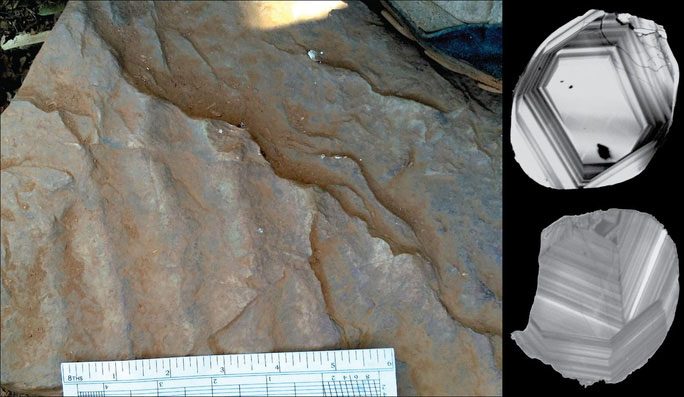Surprise about the first continent to 'pierce' the Earth's ocean
A new study has pushed back the time when the first continent appeared hundreds of millions of years back, with a very strange and mysterious way of rising out of the ocean.
The study, just published in the scientific journal PNAS, confirms that the Earth's first continent was between 3.2 and 3.3 billion years ago, based on "sedimentary rock pockets" found in India and Australia. Previously, it was thought that it was not until 2.5 billion years ago that the Earth had a continent.

One of the ancient rock formations studied - (Image: Monash University)
According to SciTech Daily, scientists led by Dr. Priyadarshi Chowdhury from Monash University's School of Earth (Australia) determined that sedimentary rocks from the two locations mentioned above are from the same period. To date, they looked for small crystals called zircons , which contain the radioactive element uranium.
Laser scanning of zircons will reveal their chemical composition, through a technique called mass spectrometry, which examines the ratio of uranium to lead. Based on the rate at which uranium decomposes to lead, the age of the rock is revealed. It shows that rocks in India and Australia "saw the world" from 3.2 to 3.3 billion years ago!
But according to Live Science, the strange thing is that at that time, the Earth did not have modern plate tectonics. So what drove the first continent to pierce the ancient ocean?
To answer that question, the scientists built a computer model based on geological and paleomagnetic data, reconstructing the conditions under which the mysterious rocks formed and their oceanic passages. .
The model shows that between 3.5 and 3.2 billion years ago, cone plumes of magma beneath the planet's crust caused parts of the cratons - early continental plates - to thicken, becoming rich in light, floating material. like silica and quartz. This makes them "physically thick and chemically light" relative to the dense surrounding rock, and gradually the whole mass rises out of the water.
The site of early continental traces in India is an area called Singhbhum Craton ; there is also the Kaapvaal Craton area in South Africa, the Pilbara Cration in Australia. All are at least 3 billion years old, although it is not clear which is representative of the first continent.
- The mysterious continent of Zealandia is transformed by the Pacific Ring of Fire
- Explore the 5 million km2 continent submerged under the Pacific Ocean
- The Australian continent tilts, moving in seasons
- Discovered the underground continent of nearly 5 million km2 hidden under the Pacific Ocean
- The Pacific subcontinent connects Australia and Antarctica
- Find the 'lost' ancient continent ... located below Europe
- Discover a small continent hidden under lava in the islands of Reunion and Mauritius
- Can take rare earths from the ocean
- Found the missing piece of ancient continent
- Discovering traces of the ancient Antarctic continent
- Ethiopia from the ashes becomes the fastest growing economy in the continent
- Learn the mystery of the 7th continent disappearing 75 million years ago
 'Fine laughs' - Scary and painful torture in ancient times
'Fine laughs' - Scary and painful torture in ancient times The sequence of numbers 142857 of the Egyptian pyramids is known as the strangest number in the world - Why?
The sequence of numbers 142857 of the Egyptian pyramids is known as the strangest number in the world - Why? History of the iron
History of the iron What is alum?
What is alum?